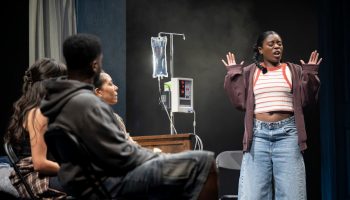
Gabriel Weber
Staff writer
Grammy Award winner Teddy Abrams returns to Chautauqua, conducting the Chautauqua Symphony Orchestra in concert with internationally renowned pianist and the Heintzelman Family Artistic Advisor for the Chautauqua Piano Program Alexander Kobrin in
a performance of Beethoven’s iconic works.
The CSO will perform Ludwig van Beethoven’s Piano Concerto No. 3 in C Minor, Op. 37 — which Korbin will be featured in — and his Symphony No. 7 in A Major, Op. 92, at 8:15 p.m. tonight in the Amphitheater under Maestro Abrams’ baton.
Kobrin keeps a Beethoven portrait in his studio, but said that no matter how well he plays, Beethoven’s frown never eases. Although Beethoven was somewhat known for his abrasive personality, it was warranted, Kobrin said, since he was losing his hearing, he had very little money and struggled with social conventions.
Beethoven’s will surpassed his circumstances, however, as he reportedly used a wooden stick pressed against his piano to feel vibrations in order to compose at this time in his life. The first movement of the concerto is powerful, exciting and dramatic, Kobrin said, while the last is rather full of humor.
The second movement is when Kobrin forgets about Beethoven’s perpetual frown.
“You have this absolutely beautiful, pure and warm music, which has nothing to do with anything — no drama, agony or anger,” Korbin said. “It’s just absolutely gorgeous.”
Beethoven’s Symphony No. 7 is a special piece for Abrams, as it was one of the very first pieces he conducted with an orchestra. The first movement is incredibly challenging, but has its own kind of sonic world, while the second movement is one of the most famous sequences Beethoven ever wrote; it’s an iconic masterpiece in terms of form, emotional control and expression.
When Abrams was given this piece as an assignment at 9 years old, he realized just how critical the role of conductor is in shaping the way a performance unfolds. The compactness of the composition made it especially fun to conduct, he said, as there’s no dead time in the piece and every single thing is connected.
“Rather than just waving your arms to keep time, I realized that every gesture has an impact and elicits a response from the musicians,” Abrams said. “It’s because of the exclusivity of that particular movement that I think I really understood that conducting starts with some of the basic things that we all observe, but has levels of nuance — psychological and emotional implications that take a lifetime of study and work and never ends. It was the second moment of this particular symphony that opened that up for me — it’s very, very special.”
After that experience at age 9, Abrams was hooked. He finds it’s a unique kind of energy source, in that conducting transcends time and language.
“I think anybody who has the rare opportunity to stand in front of an orchestra and conduct immediately senses the magic that is conducting. Providing a sonic experience for the musicians while not making a sound yourself is the great paradox of conducting, which is something that you can only fully apprehend when you’re doing it,” Abrams said. “A lot of people who have not experienced conducting, except as an observer, would assume that it’s a display of authority and power. It’s actually the total opposite — what the conductor is doing is facilitating so that the musicians can actually play their very best. You’re taking the energy that’s given to you, that you feel is kind of aggregated by the output of all the actual instrumentalists, and you’re shaping that energy and returning it to them; that’s an act of reciprocal generosity.”
An associate professor at Eastman School of Music, Kobrin finds that trusting one’s identity is paramount to the discovery of music and the world.
“You don’t have to be happy with your identity all the time. That’s why we say we learn all our lives,” Kobrin said. “There is always something to learn and experience. I’m practicing music now with the idea that every day I am experiencing something new; I’m not trying to copy paste what I’ve done yesterday. You can’t just take it from the other day, you have to rediscover it again.”
When Kobrin embarked on the journey to play all 32 of Beethoven’s sonatas — a performance in front of around 5,000 people — at Eastman, he had a “memory slip,” and his fingers just stopped moving. When he looked at the audience, he said “and so on” — they laughed, and the world kept turning.
After the concert, no one mentioned anything, except that they loved his reaction. He learned that a mistake doesn’t impact anything at all — as long as you’re able to say “and so on.”
“I’m looking forward to Beethoven in terms of anything can happen. There is a glimpse of something super fresh; either you fall or you make it,” Kobrin said. “It’s exciting, and that changes your approach to rehearsal and your playing.”
Abrams has been music director of the Louisville Orchestra since 2014; he also won Musical Conductor’s 2022 Conductor of the Year for his well-rounded approach to conducting. Engaging with civic social activism through music with the Louisville Orchestra Creators Corps, an initiative that provides a fully funded residency for three composers, and the In Harmony tour, a community-building project that takes the orchestra around Kentucky for concerts and special community events, Abrams aims to empower his community.
While the audience only sees the conductor’s role on a podium, that’s only the tip of the iceberg. In a literal sense, there is a great deal of studying, diligence and compassion involved.
“Leadership is meeting people where they are and helping them to move forward as a group, regardless of what your vision might be,” Abrams said. “You have to work with the circumstances and the realities before you to bring them to the place that they can go.”
Zooming out, Abrams believes that a conductor’s role is larger than a responsibility to the musicians he works with. Named a “maestro of the people” by The New York Times, Abrams prioritizes the understanding and serving of his community at large.
“If you’re thinking about the making of music as one element, and then a totally separate, unrelated audience as the notion of engagement and impact, then you’re going to have this really insurmountable psychological divide; I think that’s where institutions run into problems. They think about what they produce, culturally separate from the way they engage people. And those two things need to be totally joined,” Abrams said. “People are dazzled by an orchestra. They are universally drawn to what it represents and what it can do. It’s just a matter of us finding people and setting up experiences where we can expand the definition of audience.”




